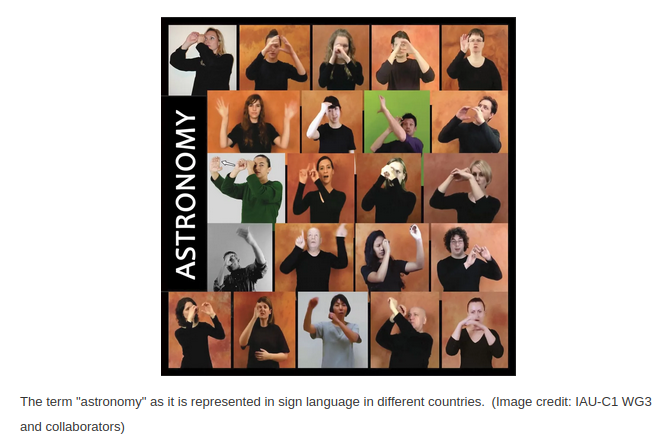Astronomy and Disability
The terms used in science in general are highly specialized. Astronomy, Astrophysics and other areas of science, does not develop on notations and symbols for the students with disabilities. For example, engagement of students who are blind, visually impaired or deaf into Astronomy faces considerable challenges.
New planets, stars, galaxies, etc. are discovered every year, and creating signs for these is a difficult task that puts students who are deaf at a disadvantage. Ensuring sign language keeps up with the new discoveries in science will ensure scholars with hearing impairment to be part of the advancement of science.
For example, sign experts are making attempts to gradually develop new universal astronomy signs [1,2,3]. Tactile and 3D printed objects to represent cosmic phenomena allows students’ enthusiasm to grow and can be used to give understandable meaning of our Universe. These researches prevent the community of people with disabilities from being excluded from modern science and teaching of several important discoveries.
On the other hand, blind or visually impaired audiences cannot participate fully in NASA’s X-ray discoveries and observations when visual media is the primary sharing mechanism. In order to address equity of accessibility to such findings, the creation of three-dimensional (3D) printed data sets to create tactile 3D models are being developed [4].
[1] Proust D. 2013 in “Astronomy in Sign Language” at
http://www.youtube.com/watch?v=ksFhan9IKKU (Retrieved Oct 2022).
[2] De Leo-Winkler M.A., Wilson G., Green W. et al. “The Vibrating
Universe: Astronomy for the Deaf”. J. Sci. Edu. & Tech. 2019; 28: 222–230.
[3] M. Wall (2017), “Astronomy for the Hearing-Impaired: New List Shows Signs for 47 Terms” (Retrieved Oct 2022).

[4] Kimberly Arcand et al., “Touching the stars: improving NASA 3D printed data sets with blind and visually impaired audiences”. J. Sci. Commun. 18(04) (2019)A01 1-22
